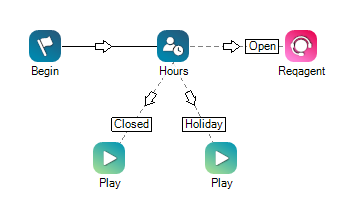|
|
Plays one or more audio file as part of the interaction. These can be pre-recorded audio files, text-to-speech (TTS) renditions of values provided in the script, or a combination of these. A common use case for this action is to play messages for the caller. For example, "Thank you for calling XYZ Company" or "Your call may be recorded for quality assurance". You can also use a Play action to deliver information to the caller by incorporating variables into the action sequence. For example, by bringing in data from a CRM or order management system, you could use a Play action to construct an order update message such as "Your recent order of {numberOfItems}, totaling {orderTotal} shipped on {shipDate]". Play does not allow you to choose a starting position or play time, but will play the entire sequence in its entirety unless DTMF is pressed when DetectDTMF is set to True. An agent cannot hear what is played through this action, it only plays audio to the contact. Also, this action does not work after onAnswer unless the onHold event has fired. Supported audio file types:
|
Supported Script Types
|
|
| Phone |
Properties
| Property | Details |
|---|---|
|
Sequence |
Determines the order in which audio files (whether pre-recorded or TTS If you enter values in the Sequence property field, you must use the correct formatting for each item. You can specify the exact text that you want the TTS service to say, such as: "%Your account balance is". You can also include variables, such as: "${accountBalance}". If you use variables, ensure that your script passes the variable value to the action containing the prompt. |
| Phrase | Use this to property to document the way the prompt should read. This property is not used by the script. Because some prompts can be complex and contain multiple segments, it can be helpful to include the text written without the formatting required by the Sequence field. |
| ClearDigits | When a contact presses a key on their telephone keypad, the generated DTMF tone is stored in a buffer. When the ClearDigits property is set to True (the default value), that buffer is cleared when the action begins. Otherwise, the action would immediately detect a DTMF tone and invoke the OnDigit or OnDTMF branch even if the key press was associated with an earlier action. |
| DetectDTMF |
Determines whether DTMF |
Branches
| Branch | Details |
|---|---|
|
Default |
Path taken unless the script meets a condition that requires it to take one of the other branches. It is also taken if the other branches are not defined. |
| OnDigit | Path taken if DTMF detection is set to True and the contact presses a key during the action. |
Tips & Tricks
- The contact center agent cannot hear the Play action.
- If you want the message to be played to both the caller and the agent, use the Whisper action.
- TTS has a limit of 300 characters.
Similar Solutions
Music, Play, Playlog, and Whisper are similar actions that are best used in different scenarios. The main differences are:
- TTS capabilities, including the use of variables
- Selecting a starting position and play time
- If the agent, contact, or both can hear what is played
- Events that affect when the action can/will fire
- Custom or CXone-provided WAV files
Phone Script Example Using Play
Play can be used in many different ways. In this example, the Hours of Operation profile determines whether the company is open, closed, or on holiday. If closed, one message will play. If on holiday, another message will play. If open, an agent will be requested.

Would you like to download this script?

